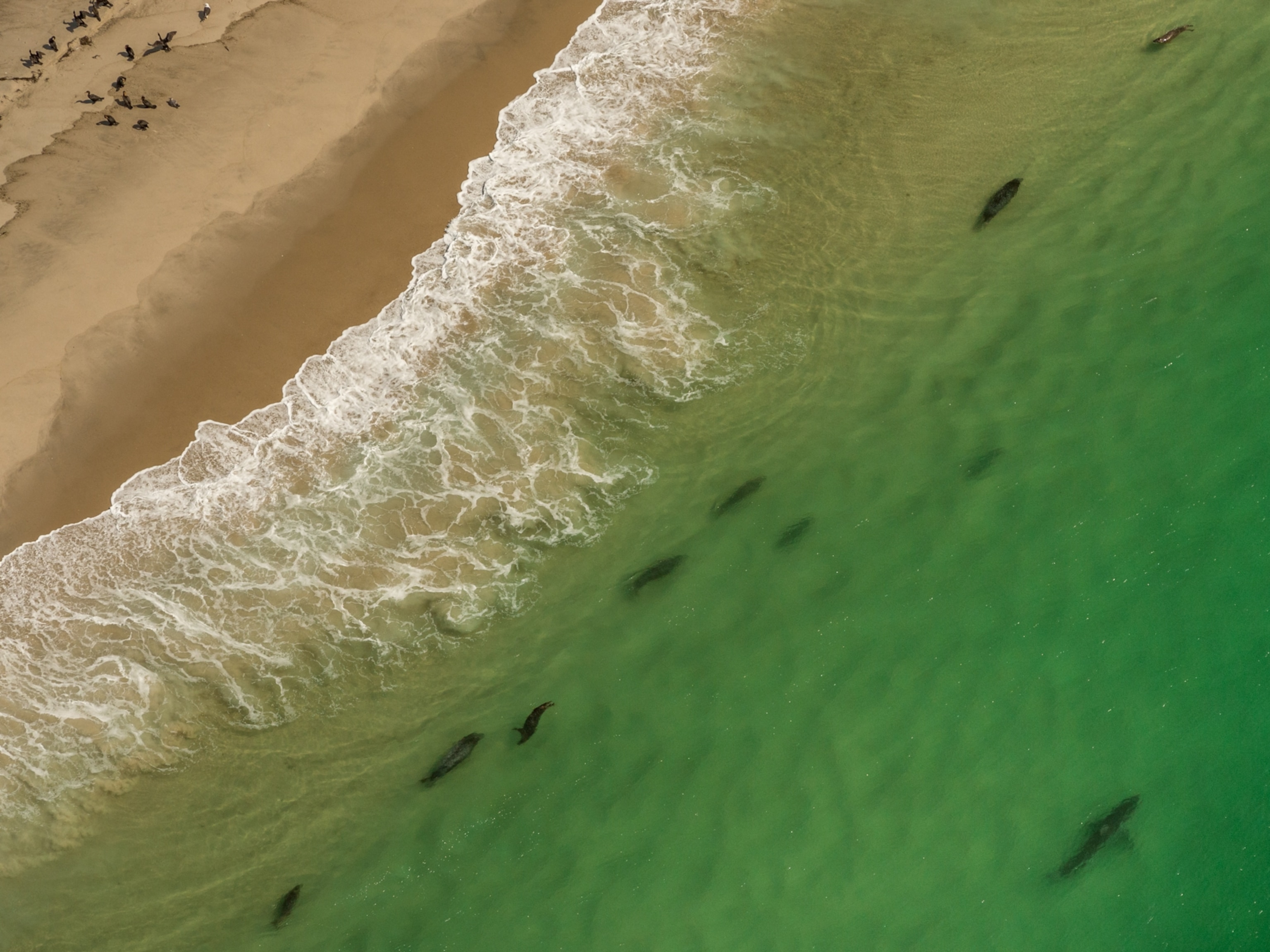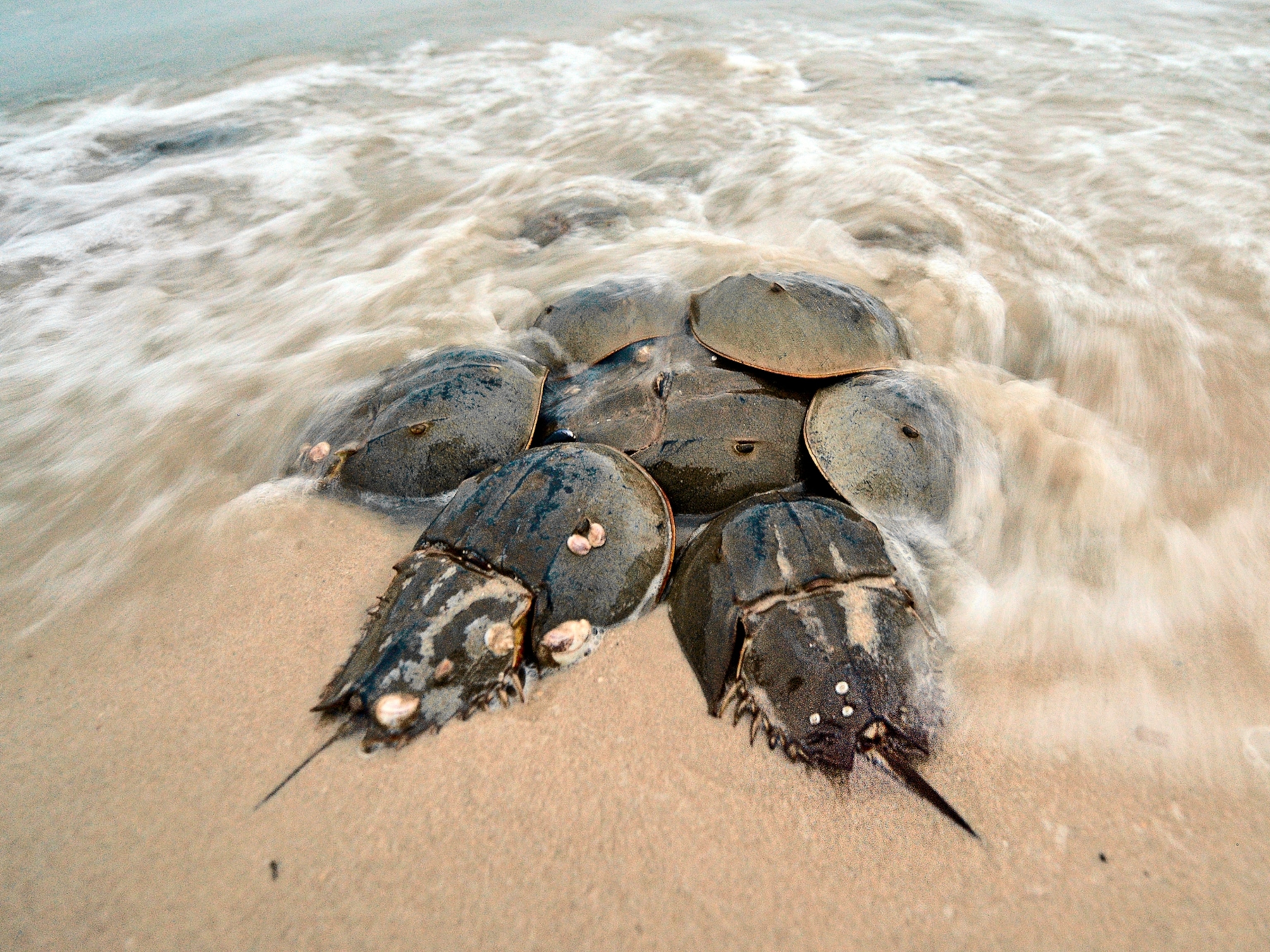
Horseshoe crab blood is key to making a COVID-19 vaccine—but the ecosystem may suffer.
Conservationists worry the animals, which are vital food sources for many species along the U.S. East Coast, will decline in number.
Each spring, guided by the full moon, hundreds of thousands of horseshoe crabs clamber onto beaches across the U.S. mid-Atlantic to lay their eggs. For hungry birds, it’s a cornucopia. For drug companies, it’s a crucial resource for making human medicines safe.
That’s because these animals’ milky-blue blood provides the only known natural source of limulus amebocyte lysate, a substance that detects a contaminant called endotoxin. If even tiny amounts of endotoxin—a type of bacterial toxin—make their way into vaccines, injectable drugs, or other sterile pharmaceuticals such as artificial knees and hips, the results can be deadly.
“All pharmaceutical companies around the world rely on these crabs. When you think about it, your mind is boggled by the reliance that we have on this primitive creature,” says Barbara Brummer, state director for The Nature Conservancy in New Jersey.
Every year, pharmaceutical companies round up half a million Atlantic horseshoe crabs, bleed them, and return them to the ocean— after which many will die. This practice, combined with overharvesting of the crabs for fishing bait, has caused a decline in the species in the region in the past few decades.
In 1990, biologists estimated 1.24 million crabs spawned in Delaware Bay, a main egg-laying spot and prime collection point for the companies. By 2002, that number had dropped to 333,500. In recent years, numbers of Delaware Bay spawning crabs have hovered around the same amount, with the 2019 survey estimating about 335,211. (The pandemic canceled the 2020 crab count.)
Catching crabs and harvesting their blood is time-consuming, and the resulting lysate costs $60,000 per gallon. In 2016, a synthetic alternative to crab lysate, recombinant factor C (rFC), was approved as an alternative in Europe, and a handful of U.S. drug companies also began using it.
But on June 1, 2020, the American Pharmacopeia, which sets the scientific standards for drugs and other products in the U.S., declined to place rFC on equal footing with crab lysate, claiming that its safety is still unproven.
Starting in July, Swiss-based Lonza will begin manufacturing a COVID-19 vaccine for human clinical trials—and they’ll have to use lysate in the vaccine if they plan to sell it in the U.S. (Here’s how we’ll know when a COVID-19 vaccine is ready.)

Human health and safety, especially for something as high stakes as the coronavirus vaccine, is paramount, says Brummer. But she and other conservationists fear that without rFC or other alternatives available, the ongoing burden on horseshoe crab blood for COVID-19 vaccines and related therapeutics may imperil the crabs and the marine ecosystems that depend on them.
A written statement from Lonza says that testing the company’s COVID-19 vaccine will not require more than a day’s worth of lysate production from the three U.S. manufacturers.
One of those three—Charles River Laboratories, based in Massachusetts—gave National Geographic the same statistic. The laboratory’s John Dubczak explained in an email that to make five billion doses of the COVID-19 vaccine, 600,000 tests will be performed, which will use the amount of lysate created in a single day.
“This places no undue burden on the [lysate] supply chain or horseshoe crab populations,” said Dubczak, executive director of reagent development and pilot program operations.
Blue bloods
Nearly unchanged for hundreds of millions of years, horseshoe crabs have some unusual traits. Despite their name, these creatures are more closely related to spiders and scorpions than crabs. They also have nine eyes—two compound eyes and seven simple ones. (Read more about how horseshoe crabs evolved.)
In 1956, medical researcher Fred Bang noticed another strange characteristic: When horseshoe crab blood interacts with endotoxin, cells called amebocytes clot and form a solid mass. Bang realized that these amebocytes—part of the crab’s ancient immune system—could detect deadly bacterial contaminants in the rapidly expanding array of pharmaceuticals designed to enter the human bloodstream.
Scientists eventually figured out how to use the amebocyte lysate to test drugs and vaccines, and in 1977, the U.S. Food and Drug Administration approved horseshoe crab lysate for this use.

Since then, each May the helmet-shaped creatures are brought en masse to specialized labs along the U.S. East Coast, where technicians extract the blood from a vein near the heart before returning them to the sea. (Their blue blood comes from the metal copper in their oxygen-transporting proteins, called hemocyanin.)
In the 1980s and through the early 1990s, the process seemed sustainable. The pharmaceutical industry claimed that only three percent of the crabs they bled died. Population surveys showed that the crabs were plentiful, and conservationists didn’t place much value on the species, says Larry Niles, a biologist with the Conserve Wildlife Foundation of New Jersey.
But by the early 2000s, the picture began to shift. Annual horseshoe crab counts during spawning season revealed smaller numbers, and a 2010 study found that as many as 30 percent of the bled crabs ultimately died—10 times as many as first estimated.
“What we’re fighting isn’t just a battle about horseshoe crabs. It’s about keeping ecosystems productive,” says Niles, who has spent his career researching the environment and species of Delaware Bay.
Lonza, the Swiss corporation, says it is “committed to protecting the welfare of the horseshoe crab,” for instance by “actively supporting conservation efforts.”
According to the statement from Lonza, Charles River Laboratories and another lysate maker, Associates of Cape Cod, Inc., raise horseshoe crabs in hatcheries and release them into the ocean. Lonza reports that in 2019, the Cape Cod company reintroduced 100,000 juvenile crabs into the waters around Massachusetts and Rhode Island.
Lonza’s statement says the company would also prefer to use lysate alternatives and has trademarked its own rFC, called PyroGene. But, as the American Pharmacopeia decision illustrates, “regulatory hurdles remain. We remain hopeful that the barriers preventing drug developers from using the synthetic alternatives are starting to fall,” the statement says.
Disrupting the food chain
Meanwhile, conservationists are monitoring the impact to the species that rely on horseshoe crab eggs as vital food sources.
Sport fish that once were numerous, such as striped bass and flounder, have plummeted in number in the region, in part due to fewer horseshoe crab eggs, Niles says. Diamondback terrapins, a type of reptile that’s vulnerable to extinction, also depend on this seasonal buffet.
Both Niles and Brummer are particularly concerned about migratory shorebirds, such as red knots and ruddy turnstones, which stop at Delaware Bay on their 9,000-mile journey from iTierra del Fuego in Chile to Arctic breeding grounds. These birds need tremendous amounts of energy for their long-distance flights, and calorie-rich horseshoe crab eggs are the perfect fuel. (Read how climate change is shrinking red knots.)
During their two-week sojourn on Delaware Bay, red knots nearly double their body weight to prepare for the final leg of their voyage. This year, however, cool temperatures delayed crab spawning, and only 30,000 red knots stayed in the bay, a drop from an estimated 40,000 birds in 2019.
Niles cautions that a weakening of one link in the food chain can reverberate, with potentially disastrous consequences. The depletion of horseshoe crabs could ultimately eliminate benefits that tourists, fishermen, and others get from enjoying the bay.
“The value of a natural resource,” he says, “doesn't belong to companies that are exploiting it. It belongs to us.”
You May Also Like
Go Further
Animals
- Octopuses have a lot of secrets. Can you guess 8 of them?
- Animals
- Feature
Octopuses have a lot of secrets. Can you guess 8 of them? - This biologist and her rescue dog help protect bears in the AndesThis biologist and her rescue dog help protect bears in the Andes
- An octopus invited this writer into her tank—and her secret worldAn octopus invited this writer into her tank—and her secret world
- Peace-loving bonobos are more aggressive than we thoughtPeace-loving bonobos are more aggressive than we thought
Environment
- This ancient society tried to stop El Niño—with child sacrificeThis ancient society tried to stop El Niño—with child sacrifice
- U.S. plans to clean its drinking water. What does that mean?U.S. plans to clean its drinking water. What does that mean?
- Food systems: supporting the triangle of food security, Video Story
- Paid Content
Food systems: supporting the triangle of food security - Will we ever solve the mystery of the Mima mounds?Will we ever solve the mystery of the Mima mounds?
- Are synthetic diamonds really better for the planet?Are synthetic diamonds really better for the planet?
- This year's cherry blossom peak bloom was a warning signThis year's cherry blossom peak bloom was a warning sign
History & Culture
- Strange clues in a Maya temple reveal a fiery political dramaStrange clues in a Maya temple reveal a fiery political drama
- How technology is revealing secrets in these ancient scrollsHow technology is revealing secrets in these ancient scrolls
- Pilgrimages aren’t just spiritual anymore. They’re a workout.Pilgrimages aren’t just spiritual anymore. They’re a workout.
- This ancient society tried to stop El Niño—with child sacrificeThis ancient society tried to stop El Niño—with child sacrifice
- This ancient cure was just revived in a lab. Does it work?This ancient cure was just revived in a lab. Does it work?
- See how ancient Indigenous artists left their markSee how ancient Indigenous artists left their mark
Science
- Jupiter’s volcanic moon Io has been erupting for billions of yearsJupiter’s volcanic moon Io has been erupting for billions of years
- This 80-foot-long sea monster was the killer whale of its timeThis 80-foot-long sea monster was the killer whale of its time
- Every 80 years, this star appears in the sky—and it’s almost timeEvery 80 years, this star appears in the sky—and it’s almost time
- How do you create your own ‘Blue Zone’? Here are 6 tipsHow do you create your own ‘Blue Zone’? Here are 6 tips
- Why outdoor adventure is important for women as they ageWhy outdoor adventure is important for women as they age
Travel
- This royal city lies in the shadow of Kuala LumpurThis royal city lies in the shadow of Kuala Lumpur
- This author tells the story of crypto-trading Mongolian nomadsThis author tells the story of crypto-trading Mongolian nomads
- Slow-roasted meats and fluffy dumplings in the Czech capitalSlow-roasted meats and fluffy dumplings in the Czech capital







